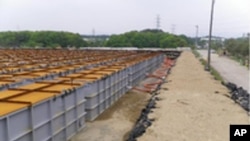The operator of Japan's crippled Fukushima nuclear power plant on Friday began a process to decontaminate more than 110,000 tons of radioactive water.
The water was used to cool the plant's reactors after a nuclear meltdown caused by a massive earthquake and tsunami in March. It has been held in reservoirs at the plant, but Tokyo Electric Power Company says those tanks are nearly full.
Company officials say they plan to remove radioactive elements, oil and salt from the water and then reuse it in the effort to fully shutdown the reactors.
But cleaning the water will create radioactive sludge, which the company will have to store.
Also Friday, the president of Indonesia, Susilo Bambang Yudhoyono, indicated his country will move cautiously on proposals to build a nuclear power plant.
Yudhoyono, while on a visit to Japan, told Japanese reporters that his country will consider all methods for meeting its energy needs, but needs to be careful about nuclear power because, like Japan, Indonesia is prone to earthquakes. Indonesia has been developing a plan to build a nuclear power plant over the next decade.
The president also expressed his sympathy for the victims of the March 11 disaster, which left more than 23,000 people dead or missing. The disaster also destroyed the homes and livelihoods of tens of thousands of people in northeastern Japan.
Japan Begins Cleaning Radioactive Water at Damaged Nuclear Plant












